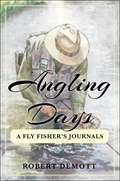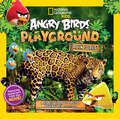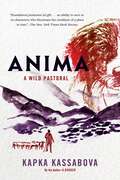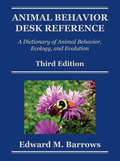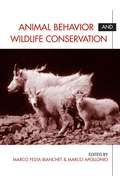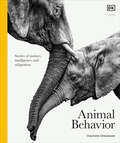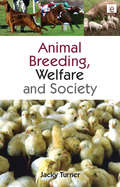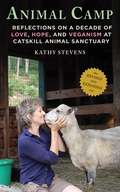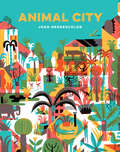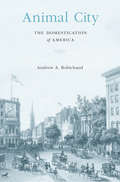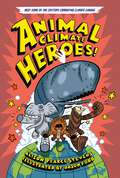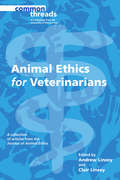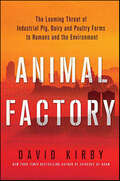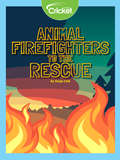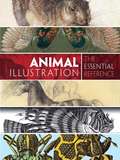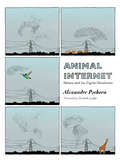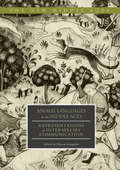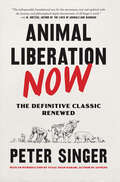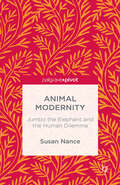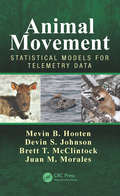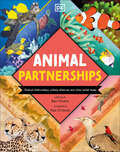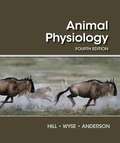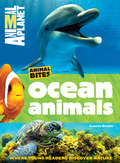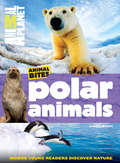- Table View
- List View
Angling Days: A Fly Fisher's Journals
by Robert DeMott“From the very first, it seems, fishing was a respite and a therapy along with all of its other potentially redemptive qualities.” —Robert DeMott Spanning more than forty-five years, Angling Days is a collection of Robert DeMott’s numerous journal entries, each a small essay in itself, jotted down during the placid moments of fishing in and along the streams and rivers of North America. Through his journaling, DeMott carries on the angling tradition of channeling the tranquility of fly fishing into creative endeavors, whether by painting, sketching, fly tying, or writing. For him, it was writing—something he did whenever he could, whether in the midst of fishing or during a break away from the water.Angling Days is a lifetime of work, a chronicle of what it is to be an angler seeking the most pristine waters and the smartest fish. It is a collection of entries and musings in the vein of DeMott’s literary hero, Henry David Thoreau, and promises to shine a new light on the art and joy of fly fishing.
Angry Birds Playground: A Forest Floor to Treetop Adventure
by Jill EsbaumFollow along with your favorite Angry Birds characters as they go on an incredible adventure through the rain forest. Kids will be hooked on a wacky mission to learn all about the rain forest so they can protect it from those bad piggies. Readers analyze and explore the most diverse ecosystem in the world as they build basic skills. Packed with learning exercises and fun activities, Angry Birds Playground: Rain Forest will transform kids into adventurers and leave them wanting more. It's a fun-tastic way to learn about a habitat in danger and the tens of thousands of creatures that call it home!
Anima: A Wild Pastoral
by Kapka KassabovaIn Anima, Kapka Kassabova introduces us to the “pastiri” people—the shepherds struggling to hold on to an ancient way of life in which humans and animals exist in profound interdependence. Following her three previous books set in the Balkans, and with an increasinging interest in the degraded state of our planet and culture, Kassabova reaches further into the spirit of place than she ever has before. In this extraordinary portrayal of pastoral life, she investigates the heroic efforts to sustain the oldest surviving breeds of our domesticated animals, and she shows us the epic, orchestrated activity of transhumance—the seasonal movement, on foot, of a vast herd of sheep, working in tandem with dogs. She also becomes more and more attuned to the isolation and sacrifices inherent in the lives shaped by this work.Weaving together lyrical writing about place with a sweeping sense of the traumatic histories that have shaped this mountainous region of Bulgaria, Kassabova shows how environmental change and industrial capitalism are endangering older, sustainable ways of living, and by extension she reveals the limited nature of so much of modern life. But shining through Kassabova’s passionate, intimate response to the monoculture that is “Anthropos” is her indelible portrait of a circulating interdependence of people and animals that might point to a healthier way to live.
Animal Behavior Desk Reference: A Dictionary of Animal Behavior, Ecology, and Evolution, Third Edition
by Edward M. Barrows"Words are our tools, and, as a minimum, we should use clean tools. We should know what we mean and what we do not, and we must forearm ourselves against the traps that language sets us." -- The Need for Precise Terminology, Austin (1957, 7-8) It follows that, for effective and efficient communication, people should have, or at least understand, th
Animal Behavior and Wildlife Conservation
by Marco Apollonio Marco Festa-BianchetEfforts to conserve wildlife populations and preserve biological diversity are often hampered by an inadequate understanding of animal behavior. How do animals react to gaps in forested lands, or to sport hunters? Do individual differences--in age, sex, size, past experience--affect how an animal reacts to a given situation? Differences in individual behavior may determine the success or failure of a conservation initiative, yet they are rarely considered when strategies and policies are developed. Animal Behavior and Wildlife Conservation explores how knowledge of animal behavior may help increase the effectiveness of conservation programs. The book brings together conservation biologists, wildlife managers, and academics from around the world to examine the importance of general principles, the role played by specific characteristics of different species, and the importance of considering the behavior of individuals and the strategies they adopt to maximize fitness.Each chapter begins by looking at the theoretical foundations of a topic, and follows with an exploration of its practical implications. A concluding chapter considers possible future contributions of research in animal behavior to wildlife conservation.
Animal Behavior: Life in the Wild (DK Definitive Visual Encyclopedias)
by DKA thrilling face-to-face encounter with animals in their own environment—their elaborate displays, intimate lives, and extraordinary behavior. Did you know that elephants give each other names, orangutans self-medicate, and rats giggle? Animal Behavior is full of hundreds of stories that shed light on how animals navigate life in the wild. Packed with vivid wildlife photography and action sequences, every aspect of animal life and behavior is explored and explained – from courtship rituals and birth to hunting and death. An initial overview of animal anatomy and physiology reveals the science and biomechanics that underpin animal behavior, while later chapters thematically break down the intricacies of animal feeding, development, communication, intelligence, learning, and other behavioral characteristics. Learn about play through river otters, see socialization among parrots at the riverbank, and catch prey with a fishing spider. Feature panels throughout the book explore the biology behind these traits, introduce case studies from the field, and highlight critical conservation issues facing these animals. Animal Behavior has been created in collaboration with internationally renowned zoologist and TV presenter Charlotte Uhlenbroek and a team of wildlife experts to ensure up-to-date and accurate information.
Animal Breeding, Welfare and Society
by Jacky TurnerThe determination of when, how, how often and with whom an animal breeds is moving rapidly away from evolutionary pressures and towards human purposes: these include the breeding of around 50 billion mammals and birds for food production annually, the breeding of pedigree dogs and cats, racing dogs and horses, specialised laboratory animal strains and the use of reproductive science to conserve endangered species or breeds and to limit unwanted populations of pests and non-native species. But the ethics and sustainability of this takeover of animals' reproductive lives have been insufficiently examined by either professionals or the public. This book discusses the methods, the motivations and the consequences of human intervention in animal breeding in terms of animal health, behaviour and well-being. It explores where we are now and the choices ahead, and looks to a future where we have more respect for animals as sentient beings and where we could loosen the reins of reproductive control.
Animal Camp: Reflections on a Decade of Love, Hope, and Veganism at Catskill Animal Sanctuary
by Kathy StevensPicking up where she left off in Where the Blind Horse Sings, Kathy Stevens regales us with more tales of the rescued animals at Catskill Animal Sanctuary (CAS), some touching, some hilarious, all provocative. We meet Barbie, the broiler hen found hiding under a blue Honda in Brooklyn who falls for the animal ambassador Rambo, a ram with an uncanny sense of what others need. Then there's Norma Rae, the turkey rescued from a "turkey bowl" just before Thanksgiving. There's also Noah, a twenty-one-year-old stallion, starved and locked in a dark stall for his entire life until he came to the safety and plenty of CAS. Claude, the giant pink free-range pig, is but another of the "underfoot family," those who roam the barnyard, free and with dignity, interacting with their own and other species in startling and profound ways. The love Stevens has for these animals, and the amount of love they give her in return, is stunning and will make any reader more thoughtful of how we treat a whole class of animals in this country. Pigs, cows, chickens, turkeys, horses, goats, sheep, and more, march into CAS and into our hearts as we learn about their quirks and personalities and what makes us human.
Animal City
by Joan NegrescolorNina journeys to a secret jungle city populated by animals, plants, and lost objects. The reason for her visit: story hour, where a book's power holds the wild in thrall. The animals are eager for stories about space, the sea, and other worlds. But their favorite story of all is the one told here: a story about a mysterious place, laden with legend and lore, and now overtaken by nature. Five Pantone colors infuse each illustrated spread with a vibrant, electric energy, making this powerful celebration of nature—and stories—as vivid visually as its narrative is engrossing.
Animal City: The Domestication of America
by Andrew A. RobichaudAmerican urbanites once lived alongside livestock and beasts of burden. But as cities grew, human–animal relationships changed. The city became a place for pets, not slaughterhouses or working animals. Andrew Robichaud traces the far-reaching consequences of this shift—for urban landscapes, animal- and child-welfare laws, and environmental justice.
Animal Climate Heroes
by Alison Pearce StevensIn our left corner we have the meanest villain that’s ever existed. Responsible for rising seas and loss of biodiversity, it’s climate change ready to wreak havoc on the Earth. But in our right corner? We have four superheroes ready to save the day!Forest elephants protect our forests by trampling trees.Whales boost ocean health with their massive poo-nados.Sea otters defend kelp forests from purple invaders.And echidnas bury tons of soil to stop climate change.But we can’t leave them in this fight alone. We need to protect our heroes who, in return, defend our planet. Get ready to learn all about these four legged, and two-flippered, creatures and how YOU can be a climate hero too!
Animal Ethics for Veterinarians (Common Threads)
by Andrew Linzey Clair LinzeyVeterinarians serve on the front lines working to prevent animal suffering and abuse. For centuries, their compassion and expertise have improved the quality of life and death for animals in their care. However, modern interest in animal rights has led more and more people to ask questions about the ethical considerations that lie behind common veterinary practices. This Common Threads volume, drawn from articles originally published in the Journal of Animal Ethics (JAE), offers veterinarians and other interested readers a primer on key issues in the field. Essays in the first section discuss aspects of veterinary oaths, how advances in animal cognition science factor into current ethical debates, and the rise of complementary and alternative veterinary medicine and its relationship to traditional veterinary medicine. The second section continues with an essay that addresses why veterinarians have an obligation to educate animal caregivers to look past "cuteness" in order to treat all animals with dignity. The collection closes with three short sections focusing on animals in farming, trade, and research ”areas where veterinarians encounter conflicts between their job and their duty to advocate and care for animals. Contributors: Judith Benz-Schwarzburg, Vanessa Carli Bones, Grace Clement, Simon Coghlan, Priscilla N. Cohn, Mark J. Estren, Elisa Galgut, Eleonora Gullone, Matthew C. Halteman, Andrew Knight, Drew Leder, Andrew Linzey, Clair Linzey, Kay Peggs, Megan Schommer, Clifford Warwick, and James W. Yeates.
Animal Factory: The Looming Threat of Industrial Pig, Dairy, and Poultry Farms to Humans and the Environment
by David KirbySwine flu. Bird flu. Unusual concentrations of cancer and other diseases. Massive fish kills from flesh-eating parasites. Recalls of meats, vegetables, and fruits because of deadly E-coli bacterial contamination. Recent public health crises raise urgent questions about how our animal-derived food is raised and brought to market. In Animal Factory, bestselling investigative journalist David Kirby exposes the powerful business and political interests behind large-scale factory farms, and tracks the far-reaching fallout that contaminates our air, land, water, and food. In this thoroughly researched book, Kirby follows three families and communities whose lives are utterly changed by immense neighboring animal farms. These farms (known as "Concentrated Animal Feeding Operations," or CAFOs), confine thousands of pigs, dairy cattle, and poultry in small spaces, often under horrifying conditions, and generate enormous volumes of fecal and biological waste as well as other toxins. Weaving science, politics, law, big business, and everyday life, Kirby accompanies these families in their struggles against animal factories. A North Carolina fisherman takes on pig farms upstream to preserve his river, his family's life, and his home. A mother in a small Illinois town pushes back against an outsized dairy farm and its devastating impact. And a Washington State grandmother becomes an unlikely activist when her home is invaded by foul odors and her water supply is compromised by runoff from leaking lagoons of cattle waste. Animal Factory is an important book about our American food system gone terribly wrong---and the people who are fighting to restore sustainable farming practices and save our limited natural resources.
Animal Firefighters to the Rescue
by Sonja ColeClimate change affects many regions with hotter and drier weather, and forest fires are a growing problem. Learn how hungry animals might help reduce wildfires. Fires need fuel, oxygen and heat to start a flame. The forest floors are covered with dry grass, dead wood, and bark called duff–fire fuel! Learn how conservationists are using sheep, goats, beavers and other animals to reduce fires!
Animal Illustration: The Essential Reference
by Carol Belanger GraftonComprehensive and entertaining, this volume comprises the greatest works in animal illustration from the Middle Ages through the twentieth century. The chronological presentation of hundreds of black-and-white and color images begins with a medieval illuminated manuscript by the Limbourg brothers and the Renaissance works of Albrecht Dürer and other artists from the first centuries of printing. Subsequent illustrations include the seventeenth-century real and imaginary animals of Matthäus Merian and the unique eighteenth-century compilations of Albertus Seba. Nineteenth-century images are drawn from sources as diverse as J. G. Heck's Bilder Atlas; the prints of Georges Baron Cuvier; William Jardine's 40-volume Naturalist's Library; bird illustrations by John James Audubon, Alexander Wilson, Edward Lear, and many others; extraordinary butterfly and insect images by E. A. Seguy, as well as animal illustrations from Victorian chromolithograph die cuts. The exquisite Edwardian bestiary of the Detmold brothers brings the collection into the twentieth century, and ends with the imagery of contemporary dinosaur artist James Gurney.Detailed bibliographical information concerning every source—including biographical details of each artist—makes this collection a vital reference tool as well as a splendid resource of outstanding animal illustrations. Students of graphic art and illustration, as well as graphic designers and advertising professionals, will prize this treasury of material from many rare historic sources.
Animal Internet: Nature and the Digital Revolution
by Alexander Pschera Elisabeth Lauffer"Animal Internet is a most important book. This excellent work could be a strong catalyst for people to rewild, to reconnect and become re-enchanted with all sorts of mysterious and fascinating animals, both local and distant. By shrinking the world it will bring humans and other animals together in a multitude of ways that only a few years ago were unimaginable."--Marc Bekoff, University of Colorado, author of Rewilding Our Hearts: Building Pathways of Compassion and Coexistence "An original book that goes against the trend to stubbornly keep nature and technology divided from one another."--Der Spiegel "Animal Internet is one of the most interesting books that I've read in recent years."--Bavarian Radio"What Pschera describes sounds futuristic but it's already widespread reality . . . Pschera's book is not just popular science: he describes not only the status quo, but also thinks about an ongoing transformation."--Wired.deSome fifty thousand creatures around the globe--including whales, leopards, flamingoes, bats, and snails--are being equipped with digital tracking devices. The data gathered and studied by major scientific institutes about their behavior will warn us about tsunamis, earthquakes and volcanic eruptions, but also radically transform our relationship to the natural world. With a broad cultural and historical perspective, this book examines human ties with animals, from domestic pets to the soaring popularity of bird watching and kitten images on the web. Will millennia of exploration soon be reduced to experiencing wilderness via smartphone? Contrary to pessimistic fears, author Alexander Pschera sees the Internet as creating a historic opportunity for a new dialogue between man and nature.Foreword by Martin Wikelski, Director, Max Planck Institute for OrnithologyAlexander Pschera, born in 1964, has published several books on the internet and media. He studied German, music, and philosophy at Heidelberg University. He lives near Munich where he writes for the German magazine Cicero as well as for German radio.
Animal Languages in the Middle Ages: Representations of Interspecies Communication (The New Middle Ages)
by Alison LangdonThe essays in this interdisciplinary volume explore language, broadly construed, as part of the continued interrogation of the boundaries of human and nonhuman animals in the Middle Ages. Uniting a diverse set of emerging and established scholars, Animal Languages questions the assumed medieval distinction between humans and other animals. The chapters point to the wealth of non-human communicative and discursive forms through which animals function both as vehicles for human meaning and as agents of their own, demonstrating the significance of human and non-human interaction in medieval texts, particularly for engaging with the Other. The book ultimately considers the ramifications of deconstructing the medieval anthropocentric view of language for the broader question of human singularity.
Animal Liberation Now: The Definitive Classic Renewed
by Peter SingerTHE UPDATED CLASSIC OF THE ANIMAL RIGHTS MOVEMENT, NOW WITH AN INTRODUCTION BY YUVAL NOAH HARARI Few books maintain their relevance—and have remained continuously in print—nearly fifty years after they were first published. Animal Liberation, one of TIME’s “All-TIME 100 Best Nonfiction Books” is one such book. Since its original publication in 1975, this groundbreaking work has awakened millions of people to the existence of "speciesism"—our systematic disregard of nonhuman animals—inspiring a worldwide movement to transform our attitudes to animals and eliminate the cruelty we inflict on them. In Animal Liberation Now, Singer exposes the chilling realities of today's "factory farms" and product-testing procedures, destroying the spurious justifications behind them and showing us just how woefully we have been misled. Now, Singer returns to the major arguments and examples and brings us to the current moment. This edition, revised from top to bottom, covers important reforms in the European Union and in various U.S. states, but on the flip side, Singer shows us the impact of the huge expansion of factory farming due to the exploding demand for animal products in China. Further, meat consumption is taking a toll on the environment, and factory farms pose a profound risk for spreading new viruses even worse than COVID-19. Animal Liberation Now includes alternatives to what has become a profound environmental and social as well as moral issue. An important and persuasive appeal to conscience, fairness, decency, and justice, it is essential reading for the supporter and the skeptic alike.
Animal Modernity: Jumbo The Elephant And The Human Dilemma
by Susan NanceThe concept of 'modernity' is central to many disciplines, but what is modernity to animals? Susan Nance answers this question through a radical reinterpretation of the life of Jumbo the elephant. In the 1880s, consumers, the media, zoos, circuses and taxidermists, and (unknowingly) Jumbo himself, transformed the elephant from an orphan of the global ivory trade and zoo captive into a distracting international celebrity. Citizens on two continents imaged Jumbo as a sentient individual and pet, but were aghast when he died in an industrial accident and his remains were absorbed by the taxidermic and animal rendering industries reserved for anonymous animals. The case of Jumbo exposed the 'human dilemma' of modern living, wherein people celebrated individual animals to cope or distract themselves from the wholesale slaughter of animals required by modern consumerism.
Animal Movement: Statistical Models for Telemetry Data
by Juan M. Morales Mevin B. Hooten Devin S. Johnson Brett T. McClintockThe study of animal movement has always been a key element in ecological science, because it is inherently linked to critical processes that scale from individuals to populations and communities to ecosystems. Rapid improvements in biotelemetry data collection and processing technology have given rise to a variety of statistical methods for characterizing animal movement. The book serves as a comprehensive reference for the types of statistical models used to study individual-based animal movement. Animal Movement is an essential reference for wildlife biologists, quantitative ecologists, and statisticians who seek a deeper understanding of modern animal movement models. A wide variety of modeling approaches are reconciled in the book using a consistent notation. Models are organized into groups based on how they treat the underlying spatio-temporal process of movement. Connections among approaches are highlighted to allow the reader to form a broader view of animal movement analysis and its associations with traditional spatial and temporal statistical modeling. After an initial overview examining the role that animal movement plays in ecology, a primer on spatial and temporal statistics provides a solid foundation for the remainder of the book. Each subsequent chapter outlines a fundamental type of statistical model utilized in the contemporary analysis of telemetry data for animal movement inference. Descriptions begin with basic traditional forms and sequentially build up to general classes of models in each category. Important background and technical details for each class of model are provided, including spatial point process models, discrete-time dynamic models, and continuous-time stochastic process models. The book also covers the essential elements for how to accommodate multiple sources of uncertainty, such as location error and latent behavior states. In addition to thorough descriptions of animal movement models, differences and connections are also emphasized to provide a broader perspective of approaches.
Animal Partnerships: Radical Relationships, Unlikely Alliances, and Other Animal Teams (Wonders of Wildlife )
by Ben HoareDiscover a whole host of partnerships from across the animal kingdom, with the nature enthusiast and best-selling author Ben Hoare.Get acquainted with unexpected animal teams around the world, and find out how these groups thrive in the wild as they defend, feed, and plot with each other in order to survive in this fascinating and unique look at animals.Presenting these unpredictable discoveries, Ben Hoare's friendly, informative explanations are paired with striking photographs and colorful illustrations to make sure every page captivates the imagination. This unique animal book for children offers: Groundbreaking scientific discoveries, including animal behaviors that have only just been documented.Impressive facts about previously unknown animal behaviors that are guaranteed to wow adults and children alike.Animals shown in incredible detail through photographs paired with charming illustration.Animal Partnerships explores cooperative relationships between sea turtles at underwater "cleaning stations" ran by surgeon fish, “bands of brothers” within particular species of big cats, and even cross-species alliances between birds and dolphins that are hungry for a shared meal. Discover how animals and plants depend upon each other to hold their territory, and how even humans have come to develop partnerships with animals all around the world.
Animal Physiology
by Margaret Anderson Richard W. Hill Gordon A. WyseAnimal Physiology presents all the branches of modern animal physiology with a strong emphasis on integration of physiological knowledge, ecology, and evolutionary biology. Integration extends from molecules to organ systems and from one physiological discipline to another.
Animal Planet Ocean Animals (Animal Bites Series)
by Laaren Brown Animal PlanetWith more than 200 gorgeous animal photos of sharks, whales, clown fish, jelly fish, dolphins, and others, Animal Planet Ocean Animals is a fun, habitat-by-habitat guide that provides kids in the first years of schooling with the perfect bite-sized view of their favorite ocean-dwelling animals. Arranged thematically with focus on animal behavior and family relationships, young readers will explore sections about animal bodies, baby animals, food, play time, conservation and more. Special book features designed for this age group include Quick Bites sidebars with cool animal facts, simple infographics, and illustrated maps of Earth's watery environments.For more Animal Bites books, check out Animal Planet Polar Animals!A portion of the proceeds will benefit Animal Planet's R.O.A.R. (Reach Out. Act. Respond.) project which partners with leading animal organization to make the world a better place for domestic and wild animals.
Animal Planet Polar Animals (Animal Bites Series)
by Laaren Brown Animal PlanetWith more than 200 gorgeous animal photos of penguins, polar bears, sea lions, walruses, reindeer and others, Animal Planet Polar Animals is a fun, habitat-by-habitat guide that provides kids in the first years of schooling with the perfect bite-sized view of their favorite animals living in both polar climates. Arranged thematically with focus on animal behavior and family relationships, young readers will explore sections about animal bodies, baby animals, food, play time, conservation, and more. Special book features designed for this age group include Quick Bites sidebars with cool animal facts, simple infographics, and illustrated maps of the coldest places on Earth. For more Animal Bites books, check out Animal Planet Ocean Animals!A portion of the proceeds will benefit Animal Planet's R.O.A.R. (Reach Out. Act. Respond.) project which partners with leading animal organization to make the world a better place for domestic and wild animals.
